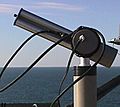Photometry (astronomy) facts for kids
Photometry is a cool way that scientists, especially astronomers, solve problems by measuring light! It's all about figuring out how much light is coming from something, like a star or a planet. This measurement is called flux.
Sometimes, scientists don't just measure the total amount of light. They also look at the different colors (or wavelengths) of light. When they do this, it's called spectrophotometry. It's like measuring how much of each color is in a rainbow coming from a star!
The word "photometry" comes from two old Greek words: "photo-", which means "light", and "-metry", which means "measure". So, it literally means "light measuring".
Contents
What is Photometry?
Photometry is a science that helps us understand how bright objects are in space. Imagine you're looking at a light bulb. Photometry helps you measure how much light that bulb is actually giving off. In astronomy, we use special tools called photometers to measure the light from distant stars, galaxies, and other space objects.
Why is Measuring Light Important?
Measuring light helps astronomers learn many things about space objects:
- How far away they are: Brighter objects might be closer, or they might be very powerful and far away. Photometry helps tell the difference.
- What they are made of: Different elements give off light in unique ways. By looking at the light, we can guess what a star is made of.
- How hot they are: Hotter objects often glow brighter or with different colors.
- How big they are: If we know how far away a star is and how bright it appears, we can figure out its actual size.
- If they have planets: Sometimes, a planet passing in front of a star can make the star's light dim slightly. Photometry can detect these tiny changes!
How Does Photometry Work?
To measure light, astronomers use telescopes with special cameras or sensors. These sensors collect the light and turn it into an electrical signal. The stronger the light, the stronger the signal. This signal is then measured and turned into a number that tells us the brightness.
Different Kinds of Light
Light isn't just what we can see. There's also light we can't see, like ultraviolet light, infrared light, and radio waves. Photometry can measure these too! Different types of light give us different clues about space objects. For example, infrared light can help us see through dust clouds to find new stars forming.
Filters and Colors
When astronomers want to measure specific colors of light, they use filters. A filter is like a colored piece of glass that only lets certain colors of light pass through. By using different filters, they can measure how much red light, blue light, or green light an object gives off. This helps them understand the object's temperature and what it's made of.
Spectrophotometry: More Than Just Brightness
While photometry measures how bright something is, spectrophotometry goes a step further. It doesn't just measure the total brightness; it measures the brightness at many different specific colors or wavelengths.
Imagine you have a musical instrument. Photometry would tell you how loud the instrument is playing. Spectrophotometry would tell you how loud each individual note is playing. This detailed information helps scientists understand the object's properties even better. For example, it can help identify specific gases around a star or in a planet's atmosphere.
Tools for Measuring Light
The main tool for photometry is a photometer. These can be simple devices or complex instruments attached to powerful telescopes.
- CCD Cameras: Many modern telescopes use CCD cameras, similar to the ones in digital cameras, to capture and measure light.
- Space Telescopes: Telescopes like the Hubble Space Telescope or the Kepler space telescope are equipped with advanced photometers to study light from space without interference from Earth's atmosphere.
Images for kids
-
Kepler Mission space photometer
-
Eta Carinae light curve in several different passbands
See also
 In Spanish: Fotometría para niños
In Spanish: Fotometría para niños




